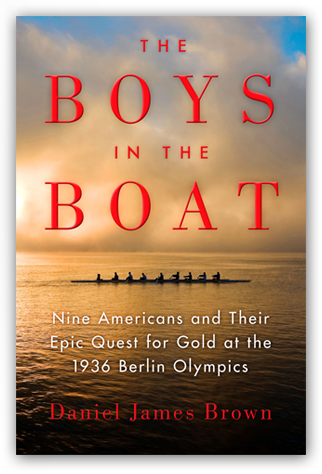There are a lot of good things about "The Boys in the Boat," the 2014 book by Daniel James Brown. In fact, there may be too many good things.
In this book, Brown brings alive the story of how nine American college boys from humble backgrounds ascended to to top of the U.S. rowing world and into the 1936 Olympics in Berlin.
Brown has a terrific eye for detail and his writing can be so vivid you would swear that he must have been an eyewitness to the events he's describing (he wasn't).
He describes female college students "wearing flower skirts and ankle socks" while "the first violet-green swallows of the year swirled among the spires of the library." For a young man working on a new dam, "sharp chips and shards of rock flew up and stung his face" while "sweat dripped from his back." Watching a race, a coach "sat alone in silence, methodically chewing a piece of gum, looking out intently from under the brim of his white cloth cap."
Still, for all of Brown's descriptive strength, there seems to be no storyline, no matter how tangentially related the main plot, that he can resist telling.
While this is purportedly a book about the sport of crew, there's a lot more in it: Brown tells us about Hitler's obsession with making the 1936 Olympics a showcase for German superiority, He explains the relationship between German filmmaker Leni Riefinstahl and Nazi propaganda minister Joseph Goebbels.
He talks about the building of the Grand Coulee dam, the Great Depression, and the Dust Bowl on the Great Plains. He explains the hardships of life in the Pacific Northwest in the 1920s and 30s. Mostly, the book is the life story of Joe Rantz, one of the rowers, and it is a story that involves a lot more than crew.
In fact, even if you took all the rowing portions out of "The Boys in the Boat," you would still have a pretty substantial book.
I'm almost a perfect target for this book -- like these young men, I grew up in the Pacific Northwest and I rowed at the University of Washington. I am familiar with many of places and the names in the book. Yet, even I got tired of Brown's frequent sidetrips onto other topics, no matter how interesting.
Rather than zipping through the water like rowing shell, this book meanders like a canoe on a lazy river.
That said, for those of us familiar with collegiate rowing, this has got to be the best crew book ever (OK, how much competition is there?). It captures the incredible interplay of muscle, brains and teamwork that it takes to move a wooden rowing shell through the water at high speed. Brown helps readers understand how each of the personalities in the boat combine to form one entity.
In may seem hard to imagine today, but as Brown outlines, crew was a major sport in the 1930s. Some 80,000 fans showed up to watch major races. A thousand fans and a marching band showed up at the train station to see the crew off on road trips. Big races got national radio coverage.
I liked that the publisher inserted the photos into the appropriate place in the story, rather than stuffing them altogether in the center, like some books do. It also has a very good index.
----------
(Please support this blog by clicking on an ad.)

No comments:
Post a Comment